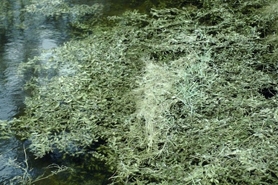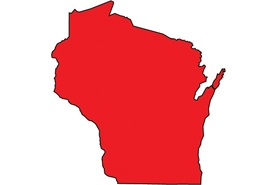Indian Swampweed
(Hygrophila polysperma)
A fast-growing aquatic plant on the federal noxious weed list in the United States. It is commonly grown in the aquarium trade and could threaten waterways if released.
Other names for this plant include:
- Common words: Miramar weed, dwarf hygrophila, hydro
- Scientific names: Justicia polysperma, Hemidelphis polysperma
Classification in Wisconsin: Prohibited
- Ecological Threat
-
- Fast growth rate at one lake in Florida - spread from 0.1 to 10 acres in one year.
- It can invade freshwater lakes, reservoirs, ponds, marshes and ditches making boating, fishing and almost all other water activities difficult.
- Degrades water quality by blocking the air-water interface and significantly reducing oxygen levels in the water, impacting underwater animals such as fish.
- Significantly reduces biological diversity: vegetation mats block sunlight, preventing the growth of submerged and emersed plant communities and altering animal communities by blocking access to the water and lowering plants the animals depend on for shelter and nesting.
- Identification
-
Leaves: grow opposite along the stems. They are rounded, hairy and up to three inches long with pointed tips. They range in color from green to brown to reddish.
Flowers: bluish-white to white with two lobes on the upper lip and three lobes on the lower lip. They grow from the axils where the leaves meet the stems.
Fruits & seeds: Narrow capsule 6-7 mm long; 20-30 tiny flattened-round seeds.
Stems: Square stems can grow up to six feet long.
Similar species: This plant could easily be confused with other aquatic species such as Ludwigia repens, Alternanthera philoxeroides and H. lacustris.
- Distribution
-
Currently, there have been no reports of Indian swampweed in Wisconsin. Have you seen it? Please send us a report.
- Control
-
Mechanical: Tiny populations can be controlled by pulling. Physical removal should be completed before the flowering and seed set. This plant can spread from fragments so care must be taken to collect and destroy all parts of the plant.
Chemical: Registered aquatic herbicides can provide some remote control of Indian swamp weed, though it shows more excellent resistance to herbicides than many other aquatic invasives. The application of aquatic herbicide requires a permit.
- Resources
- Sources for content:
- Midwest Invasive Plant Network Factsheet [exit DNR]
- The University of Florida Center for Aquatic and Invasive Plants: Factsheet [exit DNR]
- East Indian Hygrophila (Hygrophila polysperma) A Technical Review of Distribution, Ecology, Impacts, and Management [PDF] DNR publication SS-1049
Links for more information:


